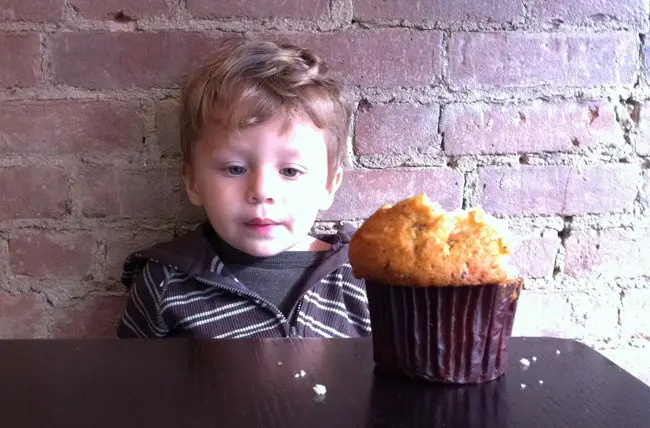If your child plays sports, whether in middle or high school, you probably have a hard time keeping your pantry stocked. Active kids eat more, or at least they should, although many parents aren’t sure just what constitutes good nutrition for young athletes. It’s no wonder the concept is confusing, says Sarah Short, Ph.D., Ed.D, a registered dietitian and sports nutritionist. “It’s not easy to generalize,” she says. Kids in early puberty and adolescence come in a stunning array of shapes, sizes, and maturity levels, and when you factor in gender differences and athletic activity, assessing your child’s nutritional needs can seem overwhelming…
– Calorie requirements for very demanding sports like football and soccer can be very high, says Dr. Short. College football linemen, for example, can require 5,000 calories per day. So unless your child is gaining too much weight, don’t be alarmed if he eats more meals than you do. Do, however, watch how your child gets her extra calories. Ideally, additional calories should come in the form of whole grains (for example, whole-grain breads and cereals, brown rice or oatmeal). Any fruits and vegetables you can add will always be beneficial. And if your child is training three or more hours a day, she can probably take in twice as much protein as her nonathletic friends. Sodas are an easy way to fill up temporarily, but they don’t provide any nutrition in return. The same goes for candy bars and, surprisingly, energy bars. “Energy bars are more or less candy bars with vitamins and minerals added,” Dr. Short advises. So your child is getting some vitamins, but he’s also getting the sugar-related energy spike of a candy bar, which will fade quickly. If he’s already taking a multivitamin supplement, the energy bar is probably not a good idea.
– Your child probably gets enough vitamins through diet alone. There’s nothing wrong with giving your child a daily multivitamin supplement, but if he’s eating fruits and vegetables every day, he’s probably fine without it. Never supplement beyond the daily DRIs (Dietary Reference Intakes). – Also avoid giving your child supplements to replace electrolytes like potassium, as a simple snack containing potassium (like bananas, potatoes, or oranges) will do the trick. Too much or too little potassium can affect the rhythms of the heart, making self-prescribed supplementation dangerous.
– What an extremely active child drinks is every bit as important as what she eats. The lack of proper hydration can be quite dangerous. “The problem is that their sense of thirst doesn’t keep up with the amount of water that they need,” Dr. Short explains. Athletes simply don’t, or can’t, drink enough while they’re exercising to replace what they lose through sweat. The best way to prevent serious dehydration, she says, is to weigh each athlete before and after practice. That way you know exactly how much water the athlete has sweated away and you can replace it accordingly. Most schools don’t practice this routine, however. Some nutritionists advocate drinking lots of water before an athletic event, says Dr. Short, but this can cause a sloshy stomach and, consequently, poor performance. Instead, she suggests, “try to have frequent intakes of small amounts of cool water during exercise.” Be sure your child also drinks plenty of water afterward, she advises.
– Drinking sports drinks in lieu of water is fine, says Dr. Short, particularly if the drink offers some calories for energy. However, make sure the sugar content is no more than 10 percent of total calories; high sugar content prevents the fluid in the drink from reaching the intestines, which is where it must go to hydrate the body. Caloric drinks are very important for athletic activities that require running for an hour or more, like cross-country running or basketball.
– Salt tablets are a no-no. It was once thought that salt losses in sweat were significant enough to need replacement, but the salt content in your child’s body actually increases in concentration after she sweats because she’s losing much more water than salt. To add salt tablets to that is dangerous.
– One sport-specific note: if your teenager is on the wrestling team, be extra vigilant about fluid intake. Because wrestling is categorized by weight, athletes are often encouraged to lose pounds to qualify for a particular wrestling class. This is sometimes accomplished, says Dr. Short, through purposeful dehydration (for example, using diuretics, wet suits, saunas, and even, incredibly, spitting). This is extremely hazardous and can stunt your child’s growth permanently.
—————————————–
It seems the intense media blitz and warnings from the medical community have now rung a bell with children. According to the first in a series of KidsHealth KidsPolls, which surveyed over 1,100 children ages 9-13 about weight-related issues, 52 percent believe there is a problem with kids being overweight. What’s more, nearly two-thirds report trying to lose weight themselves. Of the 59 percent of children who have tried to shed pounds, here’s how they said they did it:
– Went on a diet – 17 percent – Ate healthfully and exercised – 64 – Ate out less –14 percent – Took medicine – 5 percent
Although more than half of the kids consider themselves “about the right weight” (55 percent), half of those respondents say they worry about their weight. The results further show girls worry or stress more about weight than boys — 67 percent versus 41 percent, respectively. Not only do children appear to make the connection between weight and nutrition and exercise, a hopeful statistic finds that 69 percent of children say that “eating healthy and exercising” are the best way to control body weight, well ahead of the second favorite response: going on a diet (17 percent). A project of the National Association of Health Education Centers, the KidsHealth KidsPolls reveal kids’ opinions regularly throughout the school year on issues such as bullying, stress, and peer pressure. For more information on the latest survey, go to www.nahec.org/kidspoll. — Kirsten Matthew





















